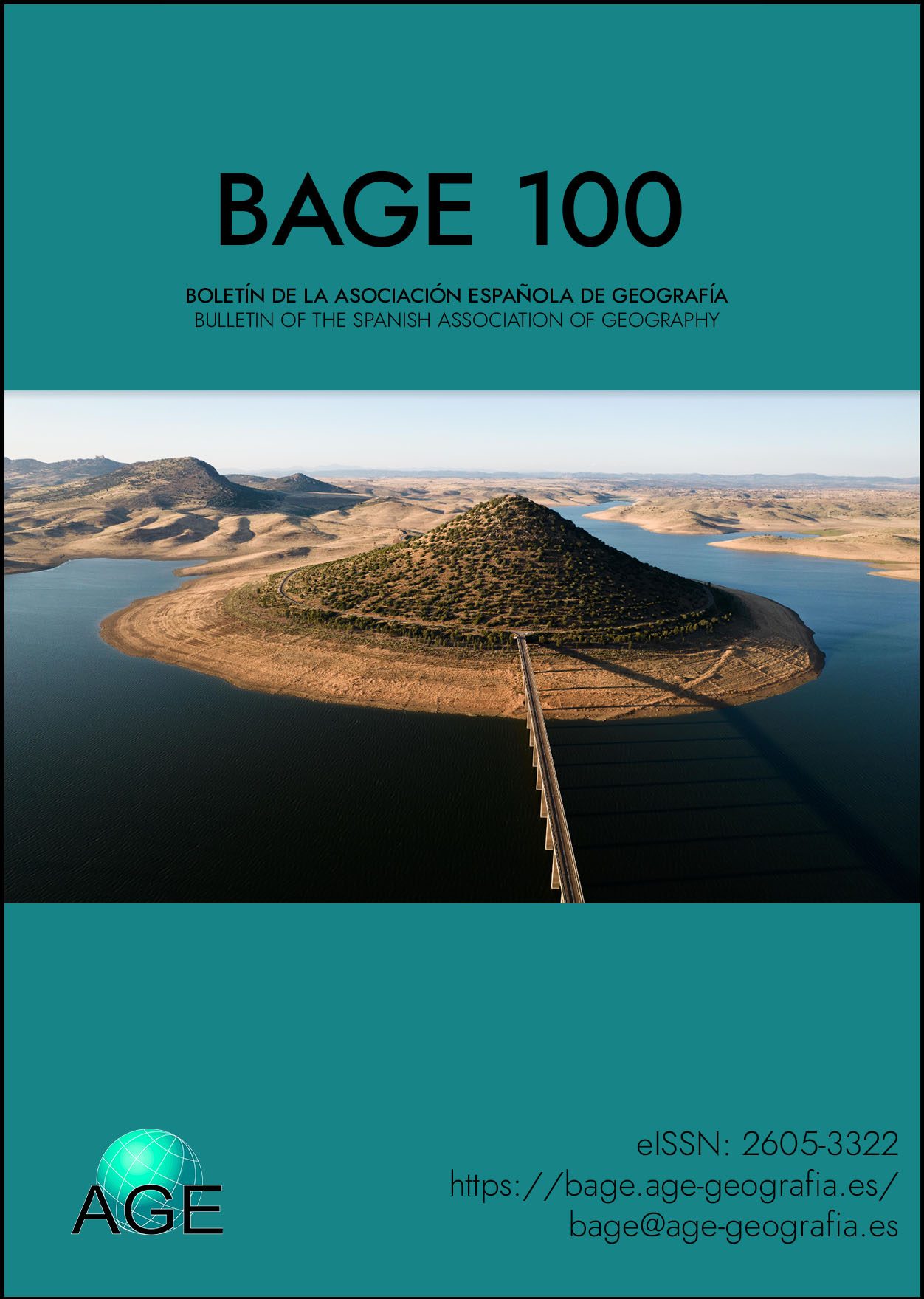Geography of football performance in Spain: the influence of population density
Main Article Content
Abstract
This article scrutinizes the geographical distribution of football success in Spain between the 1959-60 and 2019-2020 seasons. The football success of a given territory is measured by calculating the rankings obtained by its football team (or teams) at the end of each season in the first and second divisions either during the period under consideration or within different time periods. The review of the most significant literature about the geography of football success underpins our hypothesis that territorial football success is closely dependent on socio-economic dynamism at the local-regional scale. Population density is thus used to test this hypothesis by means of statistical techniques and spatial analysis. The results confirm that demographic density predicts local and provincial football success, which is concentrated in the region of Madrid, the Mediterranean coastline between Barcelona and Valencia, the eastern Cantabrian provinces, and western Andalusia. However, significant positive (higher than expected success) and negative (lower than expected success) deviations have been detected. Such deviations can only be accounted for through in-depth qualitative analyses drawing on those institutional and sociological factors that underlie the success or failure of certain provinces and clubs.
Downloads
Article Details

This work is licensed under a Creative Commons Attribution-NonCommercial 4.0 International License.
References
Bale, J. (2002). Sports Geography. Routledge.
Brachert, M. (2021). Regional effects of professional sports franchises: causal evidence from four European football leagues. Regional Studies, 55(2), 295-306. https://doi.org/10.1080/00343404.2020.1759794
Castellanos García, P., Dopico Castro, J.A., & Sánchez Santos, J.M. (2007). The Economic Geography of football success: Empirical evidence from European cities. Rivista di Diritto ed Economia dello Sport, III(2), 67-88. https://core.ac.uk/download/pdf/6396809.pdf
Cuberos Gallardo, F.J. (2014). La identidad en juego: las ligas de fútbol como espacio-tiempo para la reproducción cultural entre inmigrantes. Scripta Nova, (468). https://revistes.ub.edu/index.php/ScriptaNova/article/view/15053
Doran, J., & Jordan, D. (2018). The effect of geographical proximity and rivalry on performance: evidence from the English Football League. Regional Studies, 52(11), 1559-1569. https://doi.org/10.1080/00343404.2017.1414177
Vande Rusten, P. (2019, July 31). ¿Y si no hubiera fútbol? ¿Qué pasaría? El País. https://elpais.com/especiales-branded/es-laliga/2019/y-si-no-hubiera-futbol-que-pasaria/
Espitia Escuer, M.A., García Cebrián, L.I., & Sala Garrido, R. (2019). Productividad y sus determinantes en la competición de la UEFA Champions League. Papeles de Economía Española, (159), 180-199. https://www.funcas.es/wp-content/uploads/Migracion/Articulos/FUNCAS_PEE/159art13.pdf
Fløysand, A., & Jakobsen, S.E. (2007). Commodification of rural places: a narrative of social fields, rural development, and football. Journal of Rural Studies, 23(2), 206-221. https://doi.org/10.1016/j.jrurstud.2006.09.012
Gaubert, V. (2012). Vers une ludisation des pratiques sportives… Quand jouer au football (re)devient plaisir. Géographie et Cultures, (84), 43-62. https://journals.openedition.org/gc/2479
Gásquez, R., & Royuela, V. (2014). Is football an indicator of development at the international level? Social Indicators Research, (117), 827-848. https://link.springer.com/article/10.1007/s11205-013-0368-x
Helleu, B., & Durand, Ch. (2007). La métropolisation du sport professionnel en Europe et en Amérique du Nord: une approche comparative. Mappemonde, 88(4), http://mappemonde-archive.mgm.fr/num16/articles/art07402.html
Kate, M. (2012). Development through football in Africa: neoliberal and postcolonial models of community development. Geoforum, 43(3), 551-560. https://doi.org/10.1016/j.geoforum.2011.10.006
Lestrelin, L., & Basson, J.C. (2009). Les territoires du football: l'espace des «supporters à distance. L'Espace Géographique, 38(4), 345-358. https://dx.doi.org/10.3917/eg.384.0345
Llopis Goig, R. (2006). Clubes y selecciones nacionales de fútbol. La dimensión etnoterritorial del fútbol español. Revista Internacional de Sociología, LXIV(45), 37-66. https://doi.org/10.3989/ris.2006.i45.15
Llopis Goig, R. (2011). Práctica, consumo e identificación. La primacía del fútbol en las pautas de ocio de la sociedad española. Panorama Social, (14), 136-148. https://www.funcas.es/wp-content/uploads/Migracion/Articulos/FUNCAS_PS/014art13.pdf
Llopis Goig, R. (2019). La identificación con clubes de fútbol en España. Un análisis sociológico de su evolución de 1984 a 2014. Revista Española de Sociología, 28(3), 475-488. https://doi.org/10.22325/fes/res.2019.12
Mascarenhas, G. (2011). Le football au Brésil: réflexions sur le paysage et l'identité à travers les stades. Géographie et Cultures, (78), 59-74. http://journals.openedition.org/gc/624
Mourão, P.R. (2008). Local development and competitive soccer teams location. The Portuguese case. Investigaciones Regionales, (12), 135-143. http://hdl.handle.net/10017/30291
Picard, L. (2016). Le football efface-t-il les blessures du passe? L'image de Pologne dans les médias allemands à l'occassion du championnat d'Europe de 2012. L'Espace Géographique, 45(2), 112-123. https://doi.org/10.3917/eg.452.0112
Plaza Gutiérrez, J.I., & Caravaca Barroso, I. (2017). De la diversidad a los desequilibrios regionales y políticas correctoras: un análisis por Comunidades Autónomas. In J. Farinós Dasí y J. Olcina Cantos (Eds.), Geografía Regional de España. Espacio y comunidades (pp. 509-561). Publicaciones de la Universidad de Valencia y Tirant Humanidades.
Poli, R. (2004). L’Europe à travers le prisme du football.
Nouvelles frontières circulatoires et redéfinition de la nation. Cybergéo, (294), https://doi.org/10.4000/cybergeo.2802
Ravenel, L. (2003). Potenciales demográficos de los clubes profesionales europeos. Boletín de la Asociación de Geógrafos Españoles, (35), 191-205. https://bage.age-geografia.es/ojs/index.php/bage/article/view/450
Rodríguez-Pose, A., & Hardy, D. (2021). Reversal of economic fortunes: Institutions and the changing ascendancy of Barcelona and Madrid as economic hubs. Growth and Change, (52), 48-70. https://doi.org/10.1111/grow.12421
Santos Preciado, J.M., & García Lázaro, F.J. (2008). Análisis Estadístico de la Información Geográfica. UNED.
Transfermarkt (n.d.). Ligas nacionales & competiciones de copa. https://www.transfermarkt.es/wettbewerbe/national/wettbewerbe/157/saison_id/2019/plus/1
Théry, H. (2006). Futebol et hiérarchies urbaines au Brésil. Mappemonde, 81(1), http://mappemonde-archive.mgm.fr/num9/articles/art06103.html

